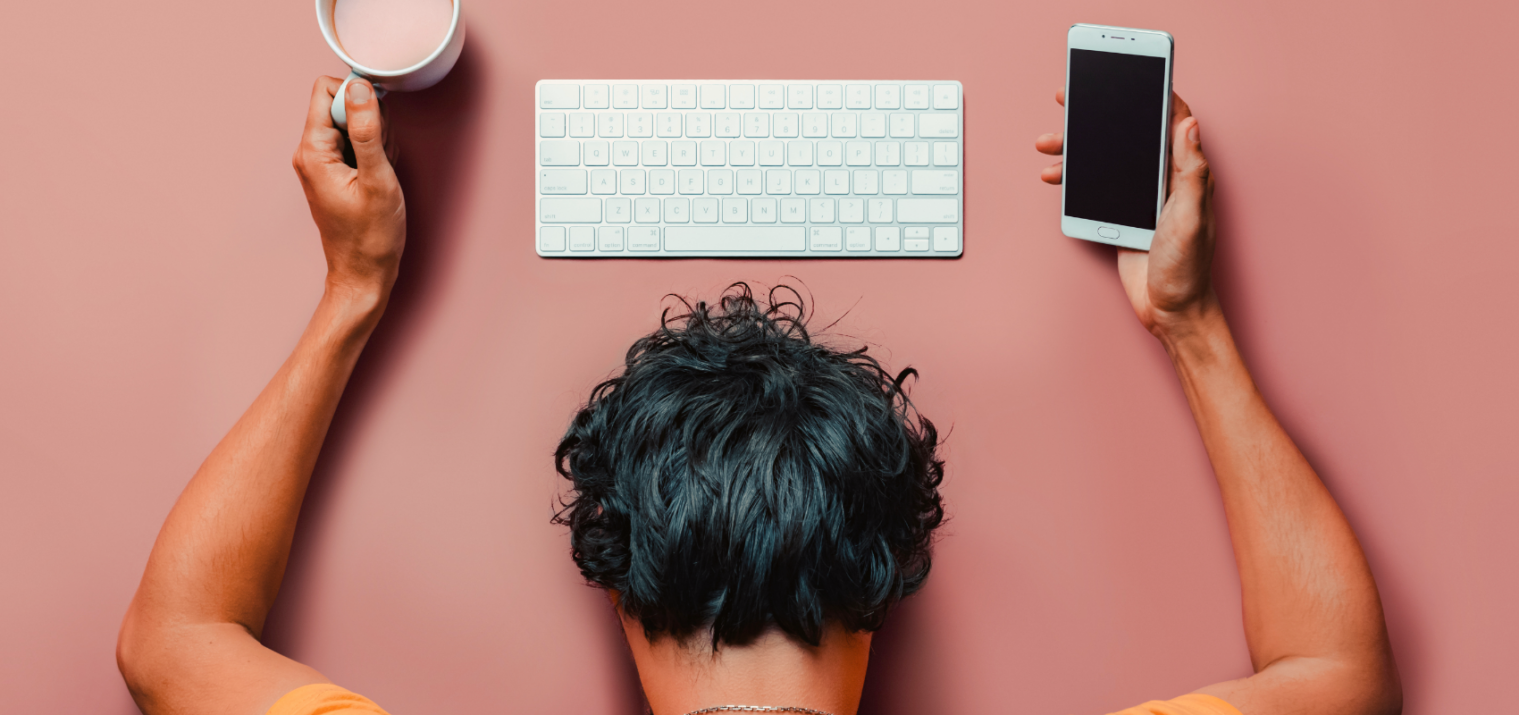
6 Tips for Reducing Digital Stress
We’ve all been there: sitting on the couch after work, checking our e-mails on an hourly basis. Our current state of constant connection to the online world does not do any good to a large majority of us, but somehow we just can’t seem to cut the cord – the FOMO is real. Digitalization does have some perks, but at the end of the day the things we might find relaxing over the short term can end up being stressful in the long term.
These days, digital stress is inevitable, and every single one of us is affected. Many people experience digital stress at work, thanks to overflowing e-mail inboxes, but even in our private lives, our phone accompanies us every second of every day, sometimes even to the bathroom! Even people who don’t have a lot to do with the digital world at work, such as those who work in factories, visiting clients, in health care, or in sanitation, cannot avoid digital content.
In this article, we are delving into digital stress, examining where it comes from, what it does to us, and how you can take 6 easy steps to reduce it over the long term.
What is digital stress, and who does it affect?
The unread e-mails pile up, you have to learn to use new software and programs, and your company keeps talking about digitalizing even more processes. Any and all of those scenarios might contribute to digital stress.
According to scientists, digital stress occurs when a situation – often at work – requires more digital competence than a person has. Based on that information, you might think that older people experience more digital stress than the younger generation, but actually, the opposite is true. A study carried out by the Hans Böckler Stiftung examined digital stress and discovered that, strangely enough, it is more pronounced in 25–34-year-olds than it is in older age groups. The study also revealed that women work with more digital tools on average than men and, when you ask men and women to rate their own digital competence, women give themselves higher ratings than men do, leading to women experiencing more digital stress.

Why digitalization can overwhelm us at work
The Böckler study analyzed why people might experience digital stress:
- Employers monitoring their performance
- Invasion of privacy
- Problems with digital programs
- Interruptions for meetings and similar
- Information overload
- Important software not available at work
- Confused by the constant switching of software
- Uncertainty regarding their own role within the company
- Difficulty working with a variety of machines and software
- Constant availability, caused by blurring of boundaries between private and professional lives
- Uncertainty regarding job security (worried they may be replaced by digital solutions)
- Feeling unsuccessful because people no longer congratulate each other on work well done in the office
What happens when digital stress gets the upper hand?
Just like many other forms of stress, digital stress can make you sick. And it’s insidious because it can creep up on you so subtly that you don’t even realize the effect that all those screens and all that scrolling are having on your nervous system. Digital stress may cause the following problems:
- Problems with the musculoskeletal system
- Cardiovascular disease
- Diseases of the nervous system
- Problems with the digestive system
- Fatigue
- Anxiety
- Irritability
- Reduced job satisfaction
Thankfully, there are some steps you can take to reduce digital stress!
Tip 1: Take a break from your phone

For most of us, our smartphone has become an essential part of life. Many people never even leave the house without their phones. Most people wake up to the sound of their phone alarm and fall asleep as they scroll through their social media. And plenty of studies have already shown that, over the long term, this has a negative effect on our body, mind, and spirit.
So it’s really important to take conscious breaks from your phone. The best way to do that is to pick a set time to deliberately put your phone away.
Smartphones themselves provide support for this behavior in the form of app limits or time-outs. For example, you could put your phone down for the night at 8 pm and not look at it until 10 am the next day when you start work. That means you are spending around 14 hours each day without your phone, giving your nervous system time to relax.
Tip 2: Be clear about when you are available and when you are not
Digitalization can quickly give us the feeling that we have to be available on all channels at all times, via e-mail, telephone, WhatsApp, Slack, and more.
But just because you own a phone and a laptop, or even work from home, doesn’t mean that you always have to be available, and it’s OK to make that clear to your boss and your co-workers!
There’s no rule saying you can’t keep your mornings free for completing work that needs doing and only make yourself available for meetings in the afternoon.
Of course, there will be exceptions, but organizing your workday into a set time for meetings and a set time for getting other work done reduces stress and allows you to concentrate fully on your morning tasks.

Tip 3: You don’t always have to answer right away
We know, we know: it’s not easy! These days, with messenger services and the fact that we are all attached to our phones, most people expect an answer within just a few hours.
But it doesn’t have to be that way! Practice not answering right away; if it’s not urgent, there’s no reason to interrupt what you are doing. Your co-workers can wait.
Of course, this will only work if you communicate clearly. Next time you see your co-workers, try saying something like “Hey, I hope you don’t mind that I don’t always answer your e-mails immediately. I like to make sure I give them the attention they deserve, and so I prefer to set aside some time to work on them, and not just answer on the fly.” We’re positive your honesty will earn you their respect, and maybe your co-workers will even follow your lead!
Tip 4: Take digital breaks
These are long periods of time in which you just don’t consume digital content. “What? How?” is likely your first reaction.
But the weekend is a great time to do this. Just leave your phone at home while you go for a long walk and admire the fall leaves. Or get really crazy and turn it off for the whole weekend.
It’s a nerve-wracking proposition – plenty of people, if they were honest with themselves, would admit that they’re pretty dependent on their smartphone.
But you can start slow and work your way up. Try short intervals of 8-12 hours, maybe at night while you sleep, and then gradually increase those intervals until your phone is off from Friday afternoon to Monday morning.
Tip 5: Practice self-care
The most important thing is to avoid disappearing into the digital world entirely. That doesn’t mean you have to swear off technology completely; it can also be a great tool for practicing self-care.
But it is important that you take conscious time away from e-mails, Messenger, WhatsApp, etc. to give your body and mind a break. The best way to do this is to establish daily media breaks and use them to concentrate on your well-being.
And the Humanoo app is here to help! It contains lots of great ideas and courses. They can help you to
- Relax your neck after a long day at work
- Cook delicious meals and eat mindfully
- Put on those sports shoes and get moving to clear your head
- Create harmony between your body and mind with a yoga session
Technology can be a practical way to help us be mindful and practice self-care, because we always have it with us. But we have to use it to really take a break, instead of getting lost in a flood of social media or work messages.

Tip 6: Look inward, not outward
We live in a fast-paced world, and we tend to focus on external things: turn off the alarm, get dressed, go to work, attend meetings, see friends in the evenings, and then fall into bed, exhausted.
The result is that we hardly ever look inward anymore. We just don’t take the time to really understand what is happening with our body, the emotions we are having, and how we feel overall. Instead, we strive to go higher, further, faster, and before we know it, we’ve burnt out. Technology can be a good way to distract yourself from how you really feel.
But taking the time to really examine your inner world will help you to identify red flags and take a break before you reach your breaking point. So what do we mean by looking inward?
There are so many meditation and mindfulness courses available in the Humanoo app that will help you get to know your own self better. And once you do, you will be able to really press pause on the outside world and take some time to take care of yourself.
So how do you plan to deal with digital stress in the future?
We hope this article has given you the courage you need to face digital stress head-on in the future, set firm boundaries, and take the breaks you need to calm your nervous system.
As always, we want to remind you that it’s OK if you can’t do it all right off the bat. Like so much of life, this is a process that requires time and practice before it can become a habit.
Our goal is to support and inspire you as you move towards a mindful life.
Your Humanoo Team